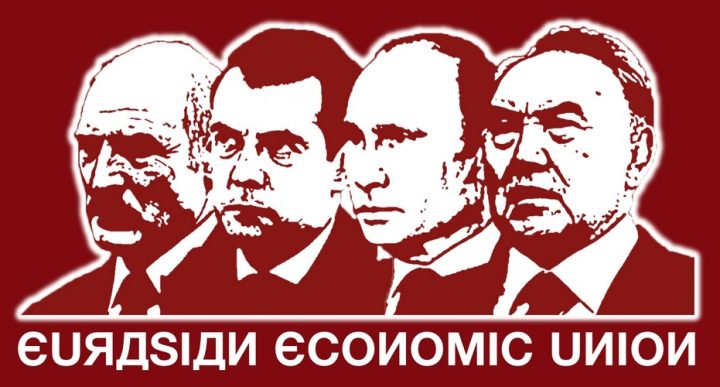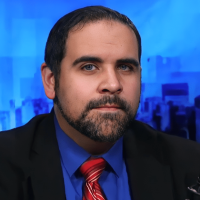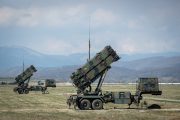
On May 29, 2014, Russian President Vladimir Putin and his Belarusian and Kazakh counterparts, Alexander Lukashenko and Nursultan Nazarbayev, respectively. met at the Kazakh capital, Astana, where they signed a treaty creating the Eurasian Economic Union, comprising Belarus, Kazakhstan, and the Russian Federation.
“The just-signed treaty is of epoch-making, historic importance,” Vladimir Putin said. According to Putin, the new treaty will bring three founding member states into a new level of integration.
Under the treaty, workers in all three countries will be granted the right to migrate and work anywhere within the Eurasian Economic Union (EAEU) without having to obtain special work permits. The treaty also calls for increased cooperation in the energy, industrial, agricultural, and transportation sectors.
Russia, Belarus, and Kazakhstan are already members in the Commonwealth of Independent States (CIS), a regional confederation of states initially created by the leadership of the Communist Party of the Soviet Union as an attempt to preserve the territorial integrity of the Union of Soviet Socialist Republics at the time of its “breakup,” in December 1991.
“In fact, we are shaping the largest common market in the CIS, with huge production, scientific and technological potential and enormous natural resources,” Putin said of the new EAEU treaty. He further elaborated:
We ensure a close and coherent economic collaboration and cooperation. Today we have created a powerful and attractive center of economic development, a large regional market that brings together more than 170 [million] people. Our union has huge reserves of natural resources, including energy, which accounts for one fifth of the world’s gas reserves and 15 percent of oil reserves.
Compromising over 170 million people, 2.5 percent of the world’s population, and accounting for 15 percent of the world’s total landmass, the new EAEU will reduce trade and other existing economic barriers between the three “ex”-Soviet republics.
“The geographical position permits us to create transport, logistic routes of not only regional, but also global importance that permits attracting massive trade flows in Europe and Asia,” Putin told reporters prior to signing ceremony for the EAEU treaty in Astana.
“A new geoeconomic reality of the 21st century is being born today,” Kazakh President Nursultan Nazarbayev said, according to Interfax news agency. Interfax further reported Putin telling Nazarbayev, “It’s your success, if not to say triumph.”
“Kazakh President Nursultan Nazarbayev first mentioned the concept of a Eurasian Union during a speech at Moscow State University in May 1994, less than three years after the breakup of the Soviet [Union],” according to the UK Telegraph.
On April 25, 2005, during his annual state of the nation address to parliament, broadcast live and nationwide on Russian television, Putin said, “First and foremost it is worth acknowledging that the demise of the Soviet Union was the greatest geopolitical catastrophe of the century.”
In October 2011, when then-Russian Prime Minister Vladimir Putin announced his intention to create a Eurasian Union, Nazarbayev strongly welcomed the idea.
Back in the USSR
Some see the rise of the Eurasian Economic Union as an attempt to restore the old Soviet Union. Speaking about Putin, during a talk at UCLA on March 5, 2014, former Secretary of State Hillary Clinton said, “I know that his political vision is of a greater Russia. I said when I was still secretary that his goal is to re-Sovietize Russia’s periphery.”
Bulat Abilov, co-chairman of Kazakhstan’s main opposition National Social Democratic Party, has also expressed similar sentiments:
Our concern is that this economical Union can develop into a political one. We also know about some plans to revive the Soviet Union, maybe in another form, in 2017 on the anniversary of the October Socialist Revolution of 1917.
Founded by Vladimir Lenin and his gang of Bolsheviks (Russian communists) following the October Socialist Revolution of 1917, the Soviet Union was the world’s first communist state. It was comprised of modern-day Russia, the main Soviet republic; Estonia, Latvia, and Lithuania in the Baltic; Kazakhstan, Kyrgyzstan, Tajikistan, Turkmenistan, and Uzbekistan in Central Asia; Belarus, Moldova, and Ukraine in East-Central Europe; and Armenia, Azerbaijan, and Georgia in the South Caucasus.
Beginning in 1917, the Soviet Union built a vast spy network and subversive apparatus made of the NKVD-KGB (secret police and intelligence agency), the intelligence agencies of satellite Eastern European states (which Moscow dominated through the Warsaw Pact), and nationals belonging to the official Communist Parties of countries all throughout the non-communist world. Together with the support of the Red Army (the then-ground army forces of Russia and the USSR), their goal was world revolution to bring about a one-world communist state.
Even today, many communists still look to Moscow for ideological guidance, pledging allegiance to Russia.
In a secret State Department cable from January 26, 2009, leaked by WikiLeaks, then-U.S. Ambassador to Italy Ronald P. Spogli observed, “Putin’s Russia bears little resemblance to Communist ideals, this fact has not deterred Italian communists and other radical left politicians from being openly pro-Russia on the basis of ideological solidarity.”
In 2012, during a speech at a conference hosted by Cliff Kincaid at the National Press Club in Washington, D.C., KGB/FSB defector Konstantin Preobrazhensky said, “Still, Russia is a Marxist country, that’s why Marxists don’t need to destroy Russian society.” Despite many claims to the contrary, Russia has never disavowed communism.
Russian Federation
In 1992, a year after then-Russian President Boris Yeltsin issued a decree banning the CPSU, it was officially restored at the 29th Congress of the Communist Party of the Soviet Union. The restored CPSU claimed to be the official successor to the original CPSU. The following year, the Union of Communist Parties–Communist Party of the Soviet Union (UCP-CPSU) was established as an international umbrella organization for all the official Communist Parties of the “former” Soviet republics.
The stated objective of the UCP-CPSU is the restoration of the USSR. The current general-secretary of the UCP-CPSU is Gennady Zyuganov, who is also the leader of the Communist Party of the Russian Federation (CPRF), an elected member of the Duma (Russian parliament), and a friend of Vladimir Putin.
The CPRF remains one of the largest political parties in Russia, second only to Putin’s United Russia Party, which is led by many “former” Communists and members of the FSB, the main successor to the Soviet-era KGB. United Russia leader and Russian President Vladimir Putin was also an officer in the KGB, director of the FSB from 1998 to 1999, and a member of the CPSU from 1975 to 1991. Russian KGB/FSB defector Konstantin Preobrazhensky stated that United Russia “shares the same ideas” of the Communist Party.
One of the most recognizable aspects of life in the Soviet Union was the collectivization of the peasants, through the creation of the kolkhoz (collective farms) and the sovkhov (state farms). Old Soviet bosses still retain their hold over the farms, including those in the private sector.
In April 1996, a month after President Yeltsin issued a decree allowing private farmers to buy and sell land, the Agrarian Party of Russia (a Marxist party that merged to form Putin’s United Russia) and the Communist Party of the Russian Federation passed legislation in Duma prohibiting individuals from buying or selling land. As a result, all land transactions are still managed by the state.
Belarus
In Belarus, Aleksandr Lukashenko continues to rule Belarus as a communist Soviet republic.
During his youth in high school, Lukashenko served as secretary of a Young Communist League chapter. In 1985, he became secretary of a collective farm’s CPSU committee. Lukashenko remained a Communist Party member until 1991, when the CPSU was disbanded. He then joined the short-lived Communists for Democracy party.
On June 23, 1994, unaffiliated with any party, Lukashenko was democratically elected as Belarus’s first president, a position that he has held uninterrupted. Although now a member of the newly formed Belaya Rus party, Lukeshenko also enjoys the support of the Communist Party of Belarus.
The Communist Party of Belarus is a hardline Marxist-Leninist party that advocates for Belarus-Russian Unionism, favoring the Eurasian Economic Union.
Kazakhstan
In Kazakhstan, President Nursultan Nazarbayev, like Lukeshenko, has also been his country’s uninterrupted ruler since assuming the presidency on December 16, 1991.
A member of the CPSU Politburo, close friend of Mikhail Gorbachev, and longtime Communist Party member since 1961, Nazarbayev was the highest-ranking Communist in the Kazakh Soviet Socialist Republic, serving in its central committee, prior to gaining its country’s “independence” from the USSR in December 1991.
Nazarbayev remained “independent” until 1999, when he formed the supposedly centrist Nor Otan party. In addition to Russia, Kazakhstan enjoys close relations with Communist China and Iran.
In 1996, Kazakhstan was one of the founding members of the Shanghai Cooperation Organization; an economic and military anti-NATO alliance comprised of virtually all of the former USSR and China, with Afghanistan, India, Iran, Mongolia, and Pakistan as observer members. In 2003, Kazakhstan hosted the SCO’s first-ever joint military exercises.
Upon the signing the new EAEU treaty, Nazarbayev expressed high aspirations that the Eurasian Union “will become a powerful incentive for modernizing our economies and helping making them global leaders.”
Eurasian Tomorrow
The formation of the Eurasian Economic Union is a major step toward what Anatoliy Golitsyn, the highest-ranking KGB agent to ever defect, referred to as the “Second October Socialist Revolution.”
Before his defection to the West in 1961, Golitsyn served as a member of the KGB’s ultra-secretive Department D, which dealt with long-range disinformation strategies. Department D was subordinate only to the Central Committee of the CPSU and was “given access to the executive branches of government and to departments of the Central Committee to enable it to prepare and carry out operations that required the approval or support of the party leadership,” Golitsyn wrote.
In 1982 Golitsyn submitted a manuscript to the CIA about Soviet disinformation strategies. With the permission of the CIA, he published his manuscript in book form in New Lies for Old in 1984. With a deep understanding of strategic long-range Soviet deception, he foresaw the coming so-called collapse of communism and the liberalization of Eastern Europe.
“‘Liberalization’ in Eastern Europe would probably involve the return to power in Czechoslovakia of Dubcek and his associates. If it should be extended to East Germany, demolition of the Berlin Wall might even be contemplated,” wrote Golitsyn, five years before those events took place.
On page 158 of his book The Perestroika Deception (1995), Golitsyn wrote, “When the right moment comes the mask will be dropped and the Russians with Chinese help will seek to impose their system on the West on their own terms as the culmination of a ‘Second October Socialist Revolution.’”
Communists are big on celebrating dates, particularly those associated with Karl Marx, Vladimir Lenin, and the October Socialist Revolution. Only three years away from the 100th anniversary of the October Socialist Revolution of 1917, what bigger way to commemorate it than with a “Second October Socialist Revolution”? We are also eight years away from 2022, which will mark the 100th anniversary of the formal creation of the Union of Soviet Socialist Republics.
It was on December 30, 1922 that delegates from the then-Russian Soviet Federative Socialist Republic, Ukrainian Soviet Socialist Republic. Byelorussian Soviet Socialist Republic, and Transcaucasian Socialist Federative Soviet Republic formally adopted the Treaty on the Creation of the USSR, which in-part formed the constitutional basis for the official creation of the Soviet Union. Again what better way for the communists of Russia and throughout the former Soviet space to celebrate the USSR’s centennial than with its restoration in 2022? Only time will tell.
With the treaty now signed, the Eurasian Economic Union is scheduled to go into effect on January 1, 2015.
The New American graphic at top depicts Lukashenko, Medvedev, Putin, and Nazarbayev in a poster format reminiscent of Soviet and Chinese communist propaganda posters depicting Marx, Engels, Lenin, Stalin, and Mao.
Related Articles:
Eurasian Union One Step Closer to Reality
Second October Socialist Revolution
Putin’s KGB/FSB Converging with New IMF Banking FSB
Convergence: Globalists Push Russia-EU Merger
Russia-China $400 Billion Energy Deal Highlights Continued Cold War




